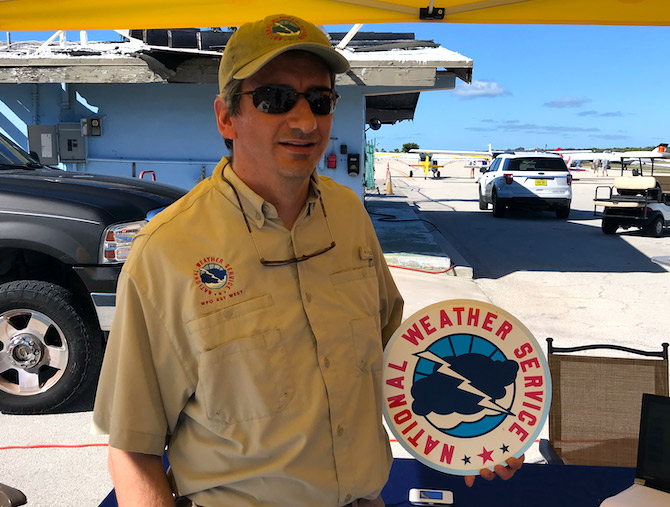
Don’t put away those hurricane shutters or eat those canned beans in the cupboard yet. Yes, we’ve gotten through the month of September — a nerve-wracking time of year that Keys locals remember as when the Hurricane of 1935 and Hurricane Irma came through. But historically, October can be an active month, as well.
Full disclosure: Keys Weekly staff was worried that writing this story would “jinx” the Florida Keys and make a storm come toward the Keys, when otherwise it would not have. When told about this possible jinx, meteorologist Jon Rizzo laughed.
“No, there’s still a lot of season to go,” Rizzo responded. “Historically, October is busier for places like the Western Caribbean and South Florida. It’s not over yet. True, we’re past the peak of the annual season, but locally a lot of storms occur during this part of October.”
Rizzo should know. The Maryland-born warning coordination meteorologist has been working for the National Weather Service out of Key West since 1999. With Hurricane Irene coming through that year, he got experience working on tropical storms immediately. Though that storm didn’t cause an enormous amount of damage, he has certainly cut his teeth through devastating storms like Hurricane Wilma in 2005 and Hurricane Irma in 2017.
Speaking of Wilma, that storm came through in the second half of October.
“We are in an active season, with 20 named storms,” he said. “For perspective, that ties with 1933 as the third most active Atlantic hurricane season on record.”
Rizzo said that though more names are still available if needed, only one name is left on the designated main list for 2021: Wanda. Then, an auxiliary list is pulled out with 21 more names.
“Whenever there’s overflow, every season we’re prepared with two 21-name lists,” he said.
In the event of a devastating storm, a name is retired. An active storm season may exhaust all names on the main list. The World Meteorological Organization, which oversees this naming system, used to use Greek letters to name storms when all names were used on the main list. But the two auxiliary lists with 21 names are now referred to instead.
Rizzo also pointed out that storms occur throughout the season in a particular geographical pattern.


At the beginning of hurricane season in June and July, storms tend to form in the Western Caribbean. Then in late August and September, the Atlantic basin gets active. In October to early November, the storms tend to form once again in the Western Caribbean.
Rizza said a high pressure system over the Atlantic Ocean called the “Bermuda High” has acted as a protective barrier for Florida this year.
“Storms have to go west or east because the high pressure has been sitting near or over us,” he noted. “That’s what’s been protecting us this season. The Bermuda High also protected us last season. In certain years, like the year of Irma, the High was further north to the east and allowed storms to track west over us.”
And though the Bermuda High has been our security guard this far in 2021, Rizzo said that could change.
“The Bermuda High can move. This is the issue with late-season storms,” he said. “You’re getting cold fronts in the Eastern U.S., and that’s shifting the Bermuda High. What these cold fronts do is break down the ‘fence’ this time of year. We don’t look toward Africa any more for formations of storms. We look toward the Western Caribbean. The position of the high pressure system really determines where storms go over us, and it’s been fortunate for us (recently) here in the Keys.”
Rizzo has one last reminder for Keys locals. Even if we dodge the bullet of a major tropical storm, it’s still rainy season, meaning there is still a potential for floods.
“We want to be careful about flooding and the king tides,” he said. “That can still have a big impact on us.”
To keep abreast of storm forecasts, Rizzo recommends going to Weather.gov/key or following the National Weather Service Key West Florida on social media.





















